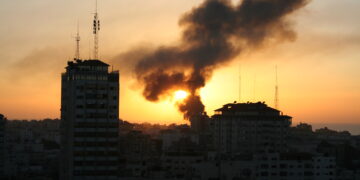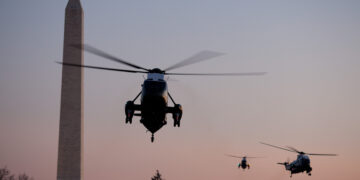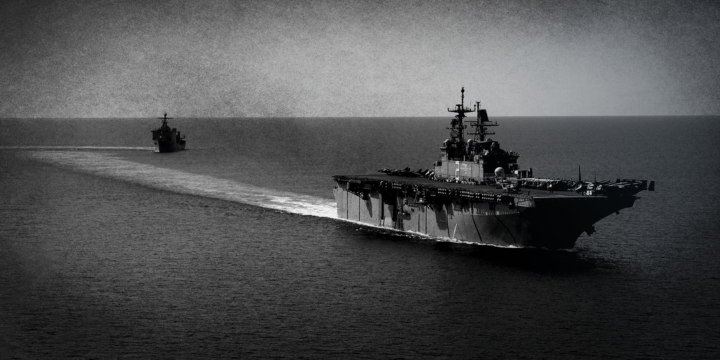January 19, 2024
Weighing additional U.S. responses to Houthi Red Sea attacks
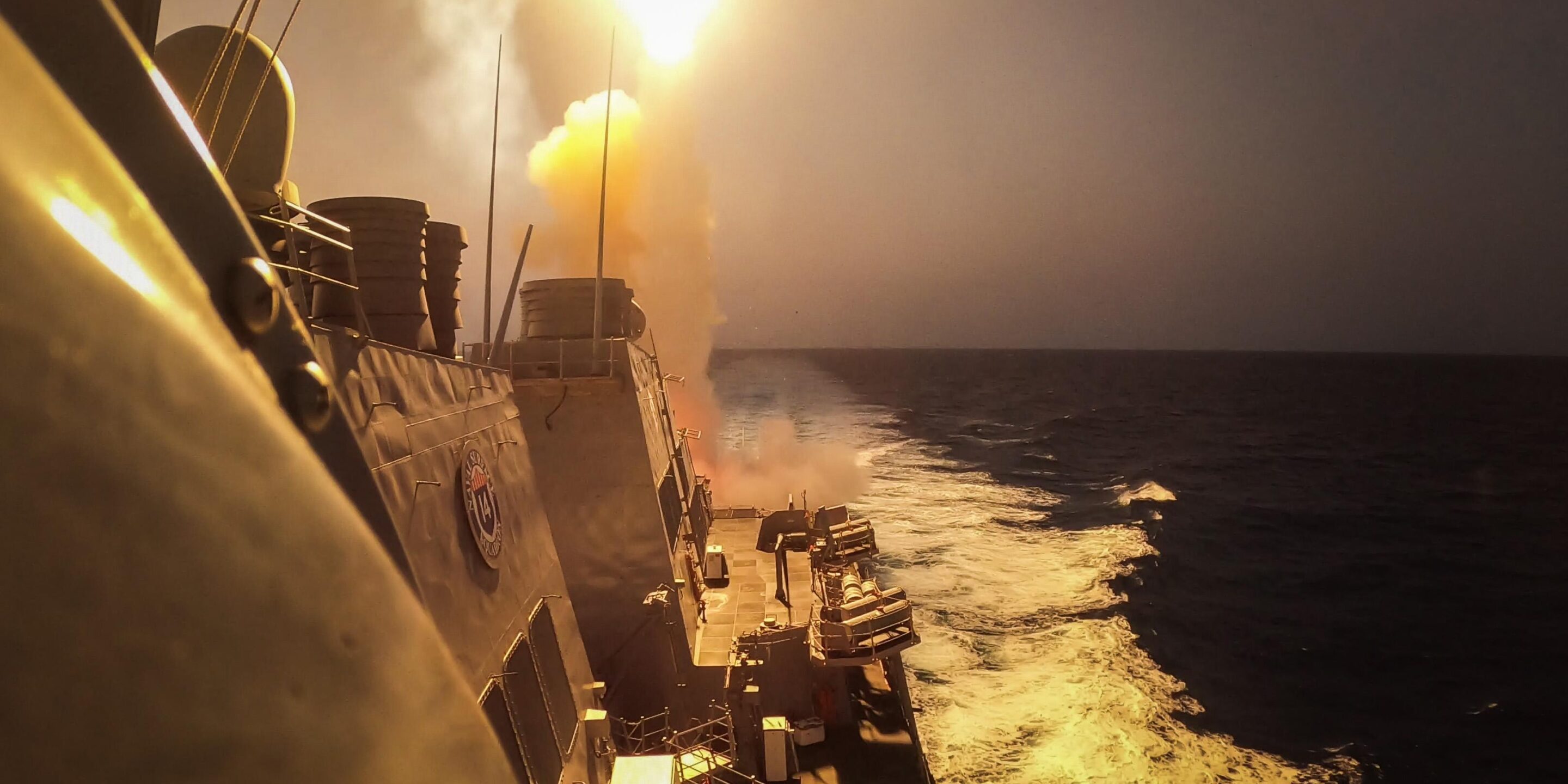
Key points
- This brief explores the advantages and drawbacks of various U.S. policy responses to attacks on commercial shipping in the Red Sea by Ansar Allah—the Shia Islamist group commonly known as the Houthi Movement. The Houthis emerged from the Yemen Civil War as the de facto government in northern Yemen and now control roughly 70 percent of the country’s population. The group was considered a Foreign Terrorist Organization (FTO) by the U.S. government until it was delisted in 2021 over humanitarian concerns about the impact of the designation.1U.S. Department of State, “Revocation of the Terrorist Designations of Ansarallah,” February 12, 2021, https://www.state.gov/revocation-of-the-terrorist-designations-of-ansarallah/.
- Since mid-November 2023, the Houthis have conducted more than 30 attacks on international vessels transiting the Red Sea and Gulf of Aden.2Jeff Seldin and Cindy Saine, “US Redesignates Yemen’s Houthis as Major Terror Group,” VOA, January 17, 2024, https://www.voanews.com/a/us-re-designates-yemen-s-houthis-as-a-major-terror-group/7443801.html. To date, the group’s drone and missile volleys have not caused casualties or sunk any ships. The overwhelming majority of Houthi attacks have either missed their targets or been defeated.3United Kingdom Maritime Trade Operation, “Recent Incidents,” https://www.ukmto.org/indian-ocean/recent-incidents. The group’s few successful hits have resulted in minimal damage with ships remaining seaworthy.4Jon Gambrell, “Houthi rebels strike a U.S.-owned ship off the coast of Yemen in the Gulf of Aden, raising tensions,” Associated Press, January 16, 2024, https://apnews.com/article/houthis-us-yemen-israel-palestinians-gaza-fa2aefc86ae002e73081e6ac1b772610.
- On January 11, 2024, the United States and United Kingdom conducted initial air and naval strikes against more than 60 Houthi targets: air defense radars, runways, coastal C2 nodes, munitions production facilities, and launch sites.5U.S. Air Forces Central, “AFCENT Commander Statement on Strikes against Houthi positions in Yemen,” January 11, 2024, https://www.afcent.af.mil/News/Article/3643851/afcent-commander-statement-on-strikes-against-houthi-positions-in-yemen/. More than 100 precision-guided munitions—including Tomahawk cruise missiles (TLAM) and high-speed anti-radiation missiles (HARM)—were launched from strike aircraft, surface combatants, and submarines. Since then, the U.S. launched continued “follow-on” strikes inside Yemen.6Jon Gambrell, Tara Copp, Aamer Madhani, and Lolita C. Baldor, “U.S. military strikes another Houthi-controlled site after warning ships to avoid parts of Red Sea,” Associated Press, January 13, 2024, https://apnews.com/article/yemen-houthis-us-ship-attacks-bombing-red-sea-iran-cc06d9186a00d1f22bea6b9c14dda12a.
- There is no credible military option that will guarantee a cessation of Houthi attacks on ships in the Red Sea. Strikes alone are unlikely to alter Houthi strategic intentions; decrease the frequency of attacks on cargo shipping; or significantly degrade Houthi one-way attack (OWA) drone, anti-ship cruise missile (ASCM), and anti-ship ballistic missile (ASBM) capabilities.
- A more extensive air campaign against the Houthis—as the Saudis attempted unsuccessfully for nearly a decade—is unlikely to succeed; would jeopardize ongoing peace talks in Yemen; would bolster domestic support for the group; and could trigger even larger Houthi and Iranian reprisals against commercial shipping, U.S. military assets in the Red Sea, or U.S. bases in the Persian Gulf or Horn of Africa.7Michael Knights and Alex Almedia, “The Saudi-UAE War Effort in Yemen (Part 2): The Air Campaign,” Washington Institute for Near East Policy, August 11, 2015, https://www.washingtoninstitute.org/policy-analysis/saudi-uae-war-effort-yemen-part-2-air-campaign.
- In weighing further responses, the U.S. should consider all aspects of national power, including diplomacy, and how to pressure other major powers to assume a more commensurate role in securing major sea lines of communication (SLOC).
Diplomatic engagement: incentives and inducements
The Houthis have repeatedly linked their motive for attacks in the Red Sea to the ongoing Israel-Hamas conflict.8“Houthis claim another Red Sea attack as shipping prices soar,” Times of Israel, January 3, 2024, https://www.timesofisrael.com/houthis-claim-another-red-sea-attack-as-shipping-prices-soar/; Jay Solomon, “U.S. considers striking Yemeni group,” Semafor, December 16, 2023, https://www.semafor.com/article/12/16/2023/us-is-considering-striking-yemeni-group. Over the course of the war, Houthi attacks have ebbed and flowed in response to events in Gaza. Houthi attacks decreased during the brief truce in November, only to resume when it ended.9“Israel–Hamas War (Iran Updates),” Institute for the Study of War, https://www.understandingwar.org/backgrounder/israel%E2%80%93hamas-war-iran-updates. As of mid-December, the group’s official spokesman reiterated that attacks on vessels transiting the Bab el-Mandeb Strait toward the Suez Canal will continue until “Gaza [receives] the food and medicine it needs.”
After the first U.S.-led air and naval strikes on January 11, senior Houthi officials stated that Washington “will pay the price for what it has done,” and reaffirmed “the goal [of the Houthis] is to stop the crimes of genocide in Gaza.”10Maziar Motamedi, Linah Alsaafin and Brian Osgood, “Israel’s war on Gaza updates: No fuel at Al-Aqsa Hospital, patients at risk,” Al Jazeera, January 12, 2024, https://www.aljazeera.com/news/liveblog/2024/1/12/israels-war-on-gaza-live-us-uk-launch-strikes-on-houthis-report. Days later, the Houthis launched an anti-ship cruise missile in the direction of the USS Laboon (DDG 58) which was ultimately shot down, and lightly damaged the U.S.-owned Marshall Islands-flagged dry bulk freighter Gibraltar Eagle with another missile.11Howard Altman, “American Fighter Downs Houthi Missile Heading Toward USS Laboon,” Drive, January 14, 2024, https://www.thedrive.com/the-war-zone/u-s-fighter-downs-houthi-missile-heading-toward-uss-laboon; Ahmed Elimam and Tala Ramadan, “Yemen’s Houthis hit US-owned dry bulk ship, no injuries – US Centcom,” Reuters, January 15, 2024, https://www.reuters.com/world/middle-east/uk-marine-monitoring-report-vessel-hit-by-missile-east-yemens-aden-2024-01-15/.
Houthi strategic intentions are unlikely to change in the aftermath of ongoing U.S. strikes, and the group has shown no signs it’s going away.12Thomas Juneau, “Negotiating Saudi Arabia’s Defeat and the Houthi Victory in Yemen,” War on the Rocks, May 15, 2023, https://warontherocks.com/2023/05/negotiating-saudi-arabias-defeat-and-the-houthi-victory-in-yemen/. As such, a policy response of diplomatic engagement could be considered. It would include incentives-based inducements and negotiation, which are low-cost options for the United States that might resolve the crisis.
- The U.S. could work to accelerate aid shipments into Gaza, which would help alleviate the humanitarian crisis there, deprive the Houthis of their justification for attacks in the Red Sea, and provide the group with an offramp for de-escalation that would also serve to prevent wider regional conflict. This would necessarily involve more diplomatic pressure on the Israeli government to allow more humanitarian assistance into Gaza.13Alex Ward, “Top Biden ally signals openness to backing conditions on Israel military aid,” Politico Europe, January 15, 2024, https://www.politico.eu/article/chris-coons-joe-biden-military-aid-israel-hamas-war/.
- The U.S. could initiate no-condition talks and induce the Houthis to cease attacks in exchange for merely acknowledging the current realities on the ground: that the group is already a pseudo-state, controls all of northern Yemen’s territory, and governs the majority of the country’s population. This could include increased foreign aid or NGO-led humanitarian assistance for civilians in Yemen or limited international recognition in exchange for a more robust agreement not to interfere with commercial shipping.
Benefits
- A diplomatic approach would serve to avoid an unpredictable and costly military campaign that would immediately compromise two stated U.S. policy objectives in the Middle East: (1) preventing the war in Gaza from spreading to other regional flashpoints and (2) ending the civil war in Yemen.
- Mitigation of the humanitarian crisis in Gaza, which would further ceasefire negotiations and efforts to end active hostilities, diminishes the risk of escalation and attacks on U.S. personnel and bases throughout the region.
- The Houthis’ status as the de facto government of Yemen obviates any perceived “bad precedents” that might apply to diplomatic negotiations with non-state actors. Bargaining and negotiation between states and armed non-state actors is a core facet of the international system.14Claudia Hofmann and Ulrich Schneckener, “Engaging non-state armed actors in state and peace-building: options and strategies,” International Review of the Red Cross 93, no. 883 (September 2011): https://www.icrc.org/en/doc/assets/files/review/2011/irrc-883-schneckener.pdf. Protracted insurgencies and “stateless” nations—such as the Kurds in Iraq and Syria—regularly conduct diplomacy, use threats of coercive violence, and enact their own foreign policies with state actors. The Houthis are no exception.
Disadvantages
- Emphasizing diplomacy could signal to terrorist groups and other non-state actors that disrupting global commerce is a viable means to achieve political or economic concessions from the United States.
- Pushing for more aid in Gaza would complicate U.S. relations with Israel, which may refuse to cooperate with any diplomatic arrangement that undermines their maximalist objective of eliminating Hamas.
- Diplomatic engagement is now much costlier to initiate, let alone achieve, following U.S. strikes in Yemen and Houthi reprisals.
Passing the buck: the U.S. can afford to do nothing
Safeguarding international sea lanes and the global commons is a global responsibility. The Pentagon has called Houthi attacks on commercial shipping, “an international problem that requires an international solution.”15U.S. Department of Defense, “Pentagon Press Secretary Air Force Maj. Gen. Pat Ryder Holds a Press Briefing,” December 12, 2023, https://www.defense.gov/News/Transcripts/Transcript/Article/3615604/pentagon-press-secretary-air-force-maj-gen-pat-ryder-holds-a-press-briefing/.
Oil is a global commodity, with a global price, so disruptions anywhere can affect price globally. The U.S., however, has not been significantly impacted by the disruption of commercial transit in the Red Sea, as most shipping through the Bab el-Mandeb Strait travels between Europe and Asia. Counterintuitively, global oil prices have declined throughout the Houthis’ interdiction campaign, likely because of strong performance from the U.S. dollar and little evidence of a more widespread supply disruption.16Shariq Khan, “Oil steadies as stronger dollar counteracts Red Sea disruptions,” Reuters, January 16, 2024, https://www.reuters.com/business/energy/oil-ticks-up-middle-east-crisis-escalates-tankers-divert-2024-01-16/.
China and Europe have plenty to lose economically over any prolonged disruption of Red Sea shipping. Beijing remains highly dependent on the Middle East for energy, receiving roughly half of its oil imports from the region, possibly deepening China’s exposure if conditions worsen.17Keith Bradsher, “China’s Economic Stake in the Middle East: Its Thirst for Oil,” New York Times, October 11, 2023, https://www.nytimes.com/2023/10/11/business/china-oil-saudi-arabia-iran.html. The cost to ship a 40-foot container from China to the Mediterranean Sea has jumped more than 70 percent in less than a month.18“Houthi threat propels surge in China-Europe maritime freight charges,” Agencia EFE, December 20, 2023, https://efe.com/en/other-news/2023-12-20/houthi-threat-propels-surge-in-china-europe-maritime-freight-charges/. This has led exporters in China and Europe to increase their use of overland rail routes, sparking fears that both could face supply shocks in the coming months if the situation in the Red Sea continues.19Jevans Nyabiage, “Red Sea attacks see exporters turn to China-Europe Railway Express ahead of Lunar New Year,” South China Morning Post, January 6, 2024, https://www.scmp.com/news/china/diplomacy/article/3247429/red-sea-attacks-see-exporters-turn-china-europe-railway-express-ahead-lunar-new-year.
The European Union is already recognizing it needs to do more, proposing a separate mission from Operation Prosperity Guardian that would deploy at least three European frigates or destroyers to the Red Sea for one year to protect shipping.20Jacopo Barigazzi, “EU wants to send warships to Red Sea to tackle Houthi attacks,” Politico Europe, January 11, 2024, https://www.politico.eu/article/gaza-israel-palestina-eu-warships-to-red-sea-to-tackle-houthi-attacks/.
By strategic inaction, the U.S. could simultaneously leverage the economic impacts of the crisis to spur European allies to assume a greater role in contributing to global security, while shifting most of the burden to China—which has four guided missile destroyers and a naval base in the Bab el-Mandeb Strait—perfectly capable of supporting defensive operations in the Red Sea and Gulf of Aden.21Kwan Wei Kevin Tan, “The Chinese Navy’s presence in the Middle East involves 6 ‘highly capable vessels’ stationed in the theater, military expert says,” Business Insider, October 26, 2023, https://www.businessinsider.com/china-navy-six-highly-capable-vessels-middle-east-military-expert-2023-10. While China has condemned disruptions to commercial shipping, it has avoided calls for harsher action against the Houthis likely in exchange for safe passage of Beijing’s merchant vessels.22Minlu Zhang, “China concerned about Red Sea shipping attacks, envoy says,” China Daily, January 4, 2024, https://www.chinadaily.com.cn/a/202401/04/WS65960fa2a3105f21a507a82c.html. Yet amid fresh calls for “all relevant parties” to respect free trade, China faces increasing freight and insurance costs that could inflict serious economic pain regardless of safe passage, and Beijing is likely still hoping U.S. military action will resolve the problem.23Joe Leahy, “China pushes for safety of Red Sea shipping as threat to its economy grows,” Financial Times, January 19, 2024, https://www.ft.com/content/fb2af70b-5971-4166-9eeb-df680590e710/.
- Enacting this policy would involve the cessation of U.S. military action in Yemen, to include a gradual drawdown of the U.S. naval presence in the Red Sea and Gulf of Aden, signaling to China and the EU that the limited interests at stake do not merit an indefinite U.S. military presence.
- As U.S. naval forces conduct a staged withdrawal, attacks on commercial shipping may increase or achieve more success, which would further disrupt global commerce. However, this might also increase the urgency for Beijing or Brussels to take further ownership of the problem.
Benefits
- China is already attempting a policy of buck passing, so Washington calling Beijing’s bluff could force Chinese President Xi Jinping to reluctantly consider other options, such as Chinese military action or direct negotiations with the Houthis or Iran, both of which should be preferable to Washington than unilateral U.S. military action.24Ambrose Evans-Pritchard, “The West is protecting China’s vital interests in the Red Sea,” Telegraph, January 16, 2024, https://www.telegraph.co.uk/business/2024/01/16/uk-us-naval-force-china-red-sea-houthi-attacks/.
- Inaction might also spur U.S. allies in Europe to develop more capacity to police shipping in the long term, as the British and French naval ships now patrolling in the area would likely prove insufficient, and little additional European naval capacity is available in the short term.
- Some analysts estimate U.S. participation in Operation Prosperity Guardian will cost $260 to $573 million per month. Strategic inaction would recoup these costs, free up significant air and naval power for more pressing needs, and eliminate even limited exposure of valuable U.S. surface combatants and aircraft carriers to a catastrophic attack in the Red Sea or Gulf of Aden.25Aaron Slodov, “For all the “$2k drone vs $2M missile” posters out there…” X, January 10, 2024, https://twitter.com/aphysicist/status/1745105913122554136.
- Fear and uncertainty—rather than successful Houthi attacks—have led to increased insurance costs that have forced shipping conglomerates to undertake timorous risk management strategies, though several firms are still transiting the Bab el-Mandeb Strait amid rumors of back channel deals.26Alex Longley, “Add Soaring Insurance Bills to Mounting Red Sea Trade Chaos,” Bloomberg, January 15, 2024, https://www.bloomberg.com/news/articles/2024-01-15/add-soaring-insurance-bills-to-mounting-red-sea-trade-chaos; Joe Easton and Christian Wienberg, “Maersk, Hapag-Lloyd Deny Reported Safe Passage Deal With Houthis,” Bloomberg, January 8, 2024, https://www.bloomberg.com/news/articles/2024-01-08/shipping-stocks-drop-after-report-of-pacts-with-houthi-rebels. If insurers try to avoid offering U.S. or UK merchant vessels war risk insurance when transiting the area, the U.S. could threaten to remove its warships from the Red Sea to coerce provision of insurance contracts in an effort to inject more stability to the market.27Alex Longley and Aine Quinn, “Insurers Seek to Exclude US, UK Ships From Red Sea Coverage,” Bloomberg, January 16, 2024, https://www.bloomberg.com/news/articles/2024-01-16/insurers-seek-to-exclude-us-uk-ships-from-red-sea-cover.
Disadvantages
- U.S. abdication would likely dissolve Operation Prosperity Guardian, perhaps causing partners and allies to similarly abandon any efforts to secure global shipping in the Red Sea. More broadly, U.S. commitments to key allies and international institutions like NATO would face scrutiny, and many bilateral U.S. relationships would be strained.
- Most European states lack large navies, sufficient missile capabilities, nearby naval bases, and the capability to conduct replenishment operations at sea over long periods of time, at least partly complicating efforts to assume a more significant role in protecting Red Sea transit.28Roger Hilton, “On the Decline of European Naval Power: a Conversation With Jeremy Stöhs, Pt. 1,” Center for International Maritime Security, September 6, 2019, https://cimsec.org/on-the-decline-of-european-naval-power-a-conversation-with-jeremy-stohs-pt-1/; Michael Peck, “Missile Gap: European Navies Have a Modern Missile Problem,” National Interest, August 23, 2021, https://nationalinterest.org/blog/reboot/missile-gap-european-navies-have-modern-missile-problem-192007.
- If China succeeded in resolving the crisis, through diplomacy or military force, it would gain global prestige and further establish itself as a key security broker and primus inter pares among major powers to most of the Middle East. Many in Washington would view this development as a drawback, though it is not clear they should.
- A strategy to pressure shipping companies themselves only makes sense as a last resort. It could risk worsening the problem by increasing market volatility and causing prices to climb.
Status quo ante: playing defense with Prosperity Guardian
Rather than indefinite air and naval strikes on Houthi targets in Yemen, which haven’t significantly degraded the group’s capabilities or altered their strategic calculus, the U.S. could focus on the “zone defense” framework of Operation Prosperity Guardian, shooting down ASBMs and OWA drones as needed to protect shipping traffic.29Patrick Wintour, “Houthi attacks continue as U.S. cargo ship hit in defiance of strikes on Yemen,” Guardian, January 15, 2024, https://www.theguardian.com/world/2024/jan/15/cargo-ship-near-yemen-reportedly-hit-by-missile-as-fears-grow-conflict-could-spread; Aziz El Yaakoubi, “Houthis vow to keep up Red Sea attacks after US-led strikes,” Reuters, January 16, 2024, https://www.reuters.com/world/middle-east/houthis-vow-keep-up-red-sea-attacks-after-us-led-strikes-2024-01-15/.
This approach has been effective, with comparatively few U.S. naval assets involved and only a handful of Arleigh Burke-class guided missile destroyers doing most of the heavy lifting. More than 30 Houthis attacks on commercial vessels to date have scored only a few superficial hits on merchant vessels. No ships have been sunk, and no crew members or civilians have been killed.30Ahmad Ghaddar, “Houthi attacks on shipping in Red Sea persist, U.S. and allies strike back,” Reuters, January 12, 2024, https://www.reuters.com/world/middle-east/houthi-attacks-shipping-red-sea-persist-us-allies-strike-back-2024-01-12/. If the U.S. wanted to return to a focus on defending Red Sea transit, this would entail simply doing more of the same.
Continue “zone defense” through the presence of U.S. air and naval assets in the Red Sea AOR, with Operation Prosperity Guardian serving as a building block to share burdens by expanding operational partners to include other major powers.
Benefits
- A strictly defensive mission has political advantages in terms of U.S. reputation and would make it easier for allies and even non-aligned major powers to join, particularly for states that have avoided participation over concerns about offensive strikes on Houthi targets in Yemen.
- Over time, continuing to repel Houthi attacks could eventually deplete more of the group’s willpower than trying to destroy them ashore. A decade of Saudi bombing in Yemen made the group adept at “shoot-and-scoot” tactics that protect their missile stockpiles. As the Houthis have hardened and concealed many of these stockpiles underground, repeated air and naval strikes in Yemen will yield diminishing returns.
- Remaining in a defensive posture allows the U.S. to achieve a key policy objective in preventing further regional escalation in the region.
Disadvantages
- An indefinite commitment to defending the Red Sea from every Houthi attack may become a politically unsustainable and financially costly posture to maintain relative to the cheap drones and missiles employed by the group.
- Defensive operations are just as unlikely to convince the Houthis to stop their attacks, which continued even after Operation Prosperity Guardian was formed.
- Unsure that the Houthi threat can be fully neutralized, some major conglomerates will hesitate to use the Red Sea as a shipping corridor and continue to opt for the longer journey around Africa, lengthening global supply chains.
- A long-term U.S. commitment to defending shipments encourages free riding among both partners and adversaries (e.g., China).
More strikes: keep attacking Houthi targets in Yemen
Continued air and naval strikes against Houthi targets in Yemen present the same problem as retaliatory U.S. airstrikes in Syria and Iraq against Shia militias: They cannot reliably “reestablish deterrence” against an asymmetric non-state actor driven by complex strategic motivations. Multiple rounds of U.S. airstrikes in Syria and Iraq, including killing Popular Mobilization Forces (PMF) commanders, have not stopped attacks on U.S. troops there.
President Biden himself all but acknowledged this, stating clearly that even though airstrikes will not stop Houthi attacks they will continue anyway.31Ryan Grim, “Biden on Yemen Airstrikes: ‘Are They Stopping the Houthis? No. Are They Gonna Continue? Yes,’” Intercept, January 18, 2024, https://theintercept.com/2024/01/18/biden-yemen-houthi-airstrikes/. To date, the U.S. has conducted multiple waves of strikes all involving similar targets and is likely to conduct more. Additional U.S. strikes will probably continue to prioritize the degradation of Houthi military capabilities where possible, rather than target the group’s leadership.
- Continued TLAM fires and naval aviation sorties will focus on any remaining Houthi launch sites, radars, or targets of opportunity (like missiles on a launchpad) that present just before or after Houthi attacks on commercial vessels.
- Repeated strikes could eventually expand to include Houthi garrisons and commanders, provided sufficient intelligence exists to target the latter. Following U.S. strikes on January 11, Houthi Brigadier General Yahya Saree announced five deaths and six injuries, underscoring that the primary targets of the strikes were the group’s military hardware rather than personnel.32Jon Gambrell, Tara Copp, Aamer Madhani, and Lolita C. Baldor, “U.S. military strikes another Houthi-controlled site after warning ships to avoid parts of Red Sea.”
- Beyond targeting Houthi personnel commanding and weaponeering the attacks, the U.S. might also expand strikes to include Iranian surveillance vessels in the Red Sea that are likely functioning as support elements for Houthi operations.33Benoit Faucon, Dov Lieber, and Gordon Lubold, “Iranian Spy Ship Helps Houthis Direct Attacks on Red Sea Vessels,” Wall Street Journal, December 22, 2023, https://www.wsj.com/world/middle-east/iranian-spy-ship-helps-houthis-direct-attacks-on-red-sea-vessels-d6f7fd40. This would mean direct kinetic action between the U.S. and Iran that would further escalate the conflict.
Benefits
- Continued strikes will probably degrade at least some Houthi ASCM and ASBM capabilities over time and will disrupt the group’s ability to conduct attacks with impunity. The Houthis will need to implement more robust operational security measures if they want to continue attacking, which may frustrate and decrease their OPTEMPO, even if U.S. strikes don’t fully eliminate the group’s anti-ship arsenal.
- With the USS Eisenhower (CVN 69) alongside four U.S. guided missile destroyers currently operating in the Red Sea AOR, continued strikes inside Yemen are relatively easy to sustain without reliance on additional U.S. military assets.
Disadvantages
- U.S. strikes in Yemen have already resulted in Houthi reprisals aimed at U.S. navy ships and commercial vessels, which sets Washington on a course to climb the escalation ladder with successively more intense attacks that could spiral into the very Middle East war that the Biden Administration claims it wants to avoid.34Paul K. Davis and Peter J. E. Stan, “Concepts and Models of Escalation,” RAND Corporation, May 1984, https://www.rand.org/content/dam/rand/pubs/reports/2007/R3235.pdf; Mai Yaghi and Leon Bruneau, “Israel bombs Gaza as Blinken says no regional escalation,” Al-Monitor, January 10, 2024, https://www.al-monitor.com/originals/2024/01/israel-bombs-gaza-blinken-says-no-regional-escalation.
- Even after multiple rounds of U.S. strikes inside Yemen, “restoring deterrence” is a remote outcome.35Noah Rothman, “The U.S. Must Restore Deterrence in the Red Sea” National Review, December 18, 2023, https://www.nationalreview.com/2023/12/the-u-s-must-restore-deterrence-in-the-red-sea/. Deterrence theory doesn’t neatly apply to asymmetric conflicts involving non-state actors.36Keith B. Payne et al., “Deterrence and Coercion of Non-State Actors: Analysis of Case Studies,” National Institute for Public Policy, October 2008, https://nipp.org/wp-content/uploads/2021/05/Summary-Report-of-Deterrence-and-Non-State-Actors.pdf; Eitan Shamir, “Deterring Non-State Actors,” NL ARMS Netherlands Annual Review of Military Studies 2020, ed. Frans Osinga and Tim Sweijs (NL ARMS), 263–286. Strikes alone have already proved insufficient to change the group’s stated intent to attack commercial shipping until the humanitarian situation in Gaza is alleviated.37Matthew Mpoke Bigg, Vivek Shankar and Thomas Fuller, “Houthis, Undeterred by Strikes, Target More Ships in Red Sea,” New York Times, January 15, 2024, https://www.nytimes.com/2024/01/15/world/middleeast/houthis-ships-red-sea.html. The Houthis also perceive substantial political benefit in defending Gaza and in opposing Washington more broadly.38Robert Wright, “Biden takes the bait in Yemen,” Nonzero Newsletter, January 12, 2024, https://nonzero.substack.com/p/biden-takes-the-bait-in-yemen. Therefore, U.S. strikes may be worse than just ineffective in deterring future attacks—they might encourage more. Standing up to the U.S. gives the Houthis an opportunity to showcase their credentials as a burgeoning global “resistance movement” and distract the Yemeni people from their poor record on governance.
- In 2016, the Houthis attacked the USS Mason (DDG 87) in the Red Sea with two ASCMs, which the Mason successfully defeated.39Barbara Starr and Caroline Kenny, “USS Mason fires missiles in Red Sea after apparent attack,” CNN, October 15, 2016, https://www.cnn.com/2016/10/15/politics/uss-mason-fired-on-again/index.html. In response to the incident, the U.S. launched TLAM strikes on Houthi radar and launch sites inside Yemen. While smaller in scale than attacks undertaken by the U.S. in recent weeks, the 2016 strikes also failed to degrade Houthi capabilities or prevent them from conducting future drone and missile attacks. Eventually, attacks lulled as the Houthis shifted focus to other targets during the civil war.
- U.S. strikes are unlikely to deny the Houthis the ability to continue attacks. The Houthis have experience mitigating the impact of protracted air campaigns, which will help them blunt the effectiveness of U.S. strikes. Through a decade of war against the Saudi-led coalition, the Houthis developed resilient logistics networks and denial and deception capabilities to include the use of decoy targets, false electronic emitters, and physical concealment.40“How the Houthis Built Their Arsenal: Defense and Intelligence Procurement,” Counter Extremism Project, November 2023, https://www.counterextremism.com/content/how-houthis-built-their-arsenal-defense-and-intelligence-procurement; Daniel Hughes, “Houthi forces deploy decoys to counter Coalition airpower,” Armament Research Services, January 7, 2019, https://armamentresearch.com/houthi-forces-deploy-decoys-to-counter-coalition-airpower/. Despite a Saudi air campaign that employed modern aircraft and precision-guided munitions, the Houthis not only won the war, but expanded their missile capabilities.41Bruce Riedel, “The Houthis have won in Yemen: What next?” Brookings Institution, February 1, 2022, https://www.brookings.edu/articles/the-houthis-have-won-in-yemen-what-next/. Initial reports on the results of U.S. strikes appear to confirm the same, indicating the Houthis relocated at least some military hardware to underground facilities in advance.42Thomas Grove and Stephen Kalin, “U.S. Launches New Strike on Houthi Radar Site in Yemen,” Wall Street Journal, January 12, 2024, https://www.wsj.com/world/middle-east/u-s-led-yemen-strikes-heighten-risk-of-broader-middle-east-conflict-aedb0006. The Houthis have limited indigenous production capabilities and will seek to import drones and missiles from Iran to replace losses. The U.S. interdiction of a small dhow (ship) carrying Iranian ballistic missile components to Yemen suggests the Houthis are continuing to exploit their robust smuggling networks.43U.S. Central Command, “USCENTCOM Seizes Iranian Advanced Conventional Weapons Bound for Houthis,” January 16, 2024, https://www.centcom.mil/MEDIA/PRESS-RELEASES/Press-Release-View/Article/3645241/uscentcom-seizes-iranian-advanced-conventional-weapons-bound-for-houthis/.
Covert action or counterterrorism: cloak and dagger
In the mid-1990s, the U.S. government began officially “designating” terrorist groups and imposing sanctions against them. Many have called for the Houthis to be redesignated as a FTO or a Specially Designated Global Terrorist (SDGT) entity.44R. Clarke Cooper, “Threats from Yemen are increasing. It’s time to redesignate the Houthis.” Atlantic Council, December 11, 2023, https://www.atlanticcouncil.org/blogs/menasource/its-time-to-redesignate-the-houthis/. An official U.S. government terrorism designation is not merely symbolic; it is also a legal mechanism to broaden the policy responses that can be used against non-state actors.
On January 17, the Biden Administration chose to designate the Houthis as an SDGT but eschewed a weightier FTO designation. An SDGT designation allows for additional political and economic tools to punish the group, while avoiding harsher measures that would end humanitarian aid to Yemeni civilians. Only a full FTO designation allows the U.S. to ban individuals from travel and enforce “material support” laws that would prevent people or groups under U.S. jurisdiction from rendering assistance to the Houthis.45Added Pub. L. 104-132, title III, §303(a), Apr. 24, 1996, 110 Stat. 1250; amended Pub. L. 107-56, title VIII, §810(d), Oct. 26, 2001, 115 Stat. 380; Pub. L. 108-458, title VI, §6603(c)-(f), Dec. 17, 2004, 118 Stat. 3762, 3763; Pub. L. 111-16, §3(6)-(8), May 7, 2009, 123 Stat. 1608. A terrorism designation also enables the Treasury Department to freeze any U.S.-held Houthi financial assets and allows agencies like the National Counterterrorism Center (NCTC) to collect and analyze intelligence on the group.
An FTO designation would also bolster the case for the President to authorize clandestine operations to disrupt, sabotage, or eliminate threats to U.S. interests, typically pursuant to a Presidential Finding under Title 50 authorities that govern lawful covert action operations.46Andru E. Wall, “Demystifying the Title 10-Title 50 Debate: Distinguishing Military Operations, Intelligence Activities & Covert Action,” Harvard National Security Journal, 2011, https://harvardnsj.org/wp-content/uploads/2012/01/Vol-3-Wall.pdf. Historically, neither an FTO designation nor a finding are necessarily required to precede approval of covert action against terrorist groups.47Joshua A. Bobich, “Note: Who Authorized this?!: An Assessment of the Process for Approving U.S. Covert Action,” William Mitchell Law Review 33, no. 3 (April 2007): 1112–1141, https://open.mitchellhamline.edu/cgi/viewcontent.cgi?referer=&httpsredir=1&article=1178&context=wmlr. While a designation can facilitate certain counterterrorism and intelligence activities, a counterterrorism approach is not the only means to conduct covert action.48Exec. Order No. 12333 3 C.F.R. (2008), https://dpcld.defense.gov/Portals/49/Documents/Civil/eo-12333-2008.pdf; Robert Chesney, “Military-Intelligence Convergence and the Law of the Title 10/Title 50 Debate,” Journal of National Security Law and Policy 5, no. 112 (October 17, 2011): 539–629, https://jnslp.com/wp-content/uploads/2012/01/Military-Intelligence-Convergence-and-the-Law-of-the-Title-10Title-50-Debate.pdf.
- To counter Houthi threats, the president could order covert action—such as non-kinetic clandestine programs or counterterrorism strikes and raids—aimed at the disruption or sabotage of Houthi military logistics and supply chains in order to sever the group’s ability to acquire or indigenously produce tactical ballistic missiles, cruise missiles, and drones.
- Depending on the scope of a Presidential Finding, the White House could authorize a covert action response narrowly tailored to counter specific Houthi capabilities or one that seeks to diminish the group’s viability more broadly.49Pam Benson, “What’s allowed by a ‘presidential finding’?” CNN, March 31, 2011, https://www.cnn.com/2011/POLITICS/03/31/libya.presidential.finding/index.html.
Benefits
- Covert action allows for specialized capabilities to be brought to bear on an adversary, using low visibility and small footprint operations to avoid the high costs and exposure associated with conventional military operations. Effective covert action relies on strong intelligence planning, clear measures for effectiveness, an actively engaged Commander-in-Chief, and guardrails on mission parameters.
- Clandestine activities don’t necessarily mean direct action. Covert action can leverage non-kinetic means, such as cyber capabilities, to degrade or destroy a target. This keeps U.S. personnel out of harm’s way and allows the U.S. to counter an adversary without resorting to war.
- Targeted counterterrorism strikes to decapitate Houthi senior leaders would throw the group into disarray at least in the short term, probably resulting in fewer attacks on commercial shipping for a brief period, as chain of command structures would be ruptured, and the Houthis would need to shift focus to identifying and establishing new leadership.
Disadvantages
- An FTO designation for the Houthis misunderstands realities on the ground in Yemen. It would be too little too late. The Houthis now control more than 70 percent of Yemen’s population and all of its critical infrastructure. The U.S. and broader international community still want the civil war in Yemen to end as quickly as possible. Dealing with the Houthis as the pseudo-state they have become, as distasteful as it may be, allows for a path to regional de-escalation. Trying to deal with the group as they were a decade ago will only mean more conflict.
- While Title 50 requires regular reporting of clandestine activities to Congress, such activities are generally subject to less oversight than conventional military operations.50July 26, 1947, ch. 343, title V, §503, as added Pub. L. 102-88, title VI, §602(a)(2), Aug. 14, 1991, 105 Stat. 442; amended Pub. L. 107-306, title III, §353(b)(3)(C), (8), Nov. 27, 2002, 116 Stat. 2402; Pub. L. 108-458, title I, §1071(a)(1)(Y), Dec. 17, 2004, 118 Stat. 3689; Pub. L. 111-259, title III, §331(c), Oct. 7, 2010, 124 Stat. 2685; Pub. L. 113-126, title III, §308, July 7, 2014, 128 Stat. 1397; M.E. Bowman, “Secrets in Plain View: Covert Action the U.S. Way,” International Law Studies 72 (1998): 1–16, https://digital-commons.usnwc.edu/cgi/viewcontent.cgi?article=1470&context=ils; Richard A. Best Jr., Covert Action: An Effective Instrument of U. S. Foreign Policy? (Washington, DC: Congressional Research Service, 1996), https://www.everycrsreport.com/files/19961021_96-844_a3fe515109001b58e7be8b2af3841f9e91066400.pdf. Plausible deniability in covert operations is also difficult if not impossible to achieve and, even when successful, can function counterintuitively by fueling adversary misperception and misdirected reprisals that can escalate a conflict.51Rory Cormac and Richard J. Aldrich, “Grey is the new black: covert action and implausible deniability,” International Affairs 94, no. 3 (May 2018): 477–494.
- Like other U.S. counterterrorism missions, a CT-centric response to the Houthis would entail significant economic costs, as well as the reorientation of limited intelligence and national defense resources from hard targets like Russia or China to support a multi-decade shadow war with specious U.S. interests at stake that could easily expand beyond its original scope.52Neta C. Crawford, “The U.S. Budgetary Costs of the Post-9/11 Wars,” Costs of War Project, Watson Institute for International and Public Affairs, September 1, 2021, https://watson.brown.edu/costsofwar/files/cow/imce/papers/2021/Costs%20of%20War_U.S.%20Budgetary%20Costs%20of%20Post-9%2011%20Wars_9.1.21.pdf.
- A counterterrorism approach would imply an effort to oust the Houthis from power in Yemen, which will likely not only fail, but also ensure the Houthis behave as international “outlaws” with no means to remedy their behavior or integrate with the region.
- A successful regime change effort, however unlikely, might still prove pyrrhic by keeping Yemen in chaos. There are no good alternatives to the Houthis as Yemen’s central government: The Saudi-backed Republic of Yemen Government (ROYG) in exile lost its popular remit over a decade ago; the Southern Transitional Council (STC) holds small pockets of Yemeni coastline but remains interested in a secessionist microstate, not national governance; and surely al-Qa’ida in the Arabian Peninsula (AQAP) or the Islamic State in Yemen (ISIS-Y) would not be an improvement.
- Even if the U.S. wanted to install a new government in Yemen—leaving aside any legal, ethical, or political issues—the lack of a large and capable proxy force necessary to effectuate such an outcome would require hundreds of thousands of U.S. troops to carry out the mission. Most concerning, the beneficiaries of any major ground war in Yemen would be AQAP, ISIS-Y, and other jihadist groups. Amid the chaos, they would be able to avoid security pressure, regain freedom of movement, seize territory, recruit more members, and plot attacks against the West.
- A U.S. ground war in Yemen could also provide more leverage to Iran and its proxies in the region, who would gain yet another opportunity—outside of Syria and Iraq—to harass American troops and bog down the U.S. politically whenever doing so is deemed desirable.
- There are no existential or vital U.S. national interests at stake in Yemen, and very little is at stake for the U.S. economically in the Red Sea. As such, a multi-decade, multi-billion-dollar effort to oversee regime change there would deliver political, economic, and security costs, not benefits.
Conclusion: no perfect solution, but overreaction is unwise
This analysis presented costs and benefits of various policy responses toward Houthi attacks on Red Sea shipping without prescribing one. The analysis, however, leads to several general observations that might clarify the choices in play for policymakers:
- Some of these policy options are potentially complementary, depending on how they are implemented. They are also not mutually exclusive. Diplomacy, for example, can exist alongside threats, naval operations, and even strikes in Yemen, with U.S. strikes arguably helping to establish Washington’s will to inflict punishment that might precede offered benefits for the Houthis ending attacks on shipping.
- While no policy option is without a downside, the “lower-end” response options explored—such as diplomacy, buck-passing, and defensive action—are all perfectly viable while remaining unlikely to result in some terrible outcome for the U.S. As such, these options should be considered more thoroughly in the policy debate than has been the case to this point.
- The “higher-end,” more aggressive and ambitious policy response options considered—like indefinite airstrikes in Yemen or a broader counterterrorism campaign—present dubious prospects for success. In the unlikely event of success, these approaches would do little to advance or secure any of the limited U.S. interests in the region and would come at great cost. Moreover, in many cases, these responses carry far-reaching commitments and risks for the U.S. that include a non-trivial possibility of regional war that, at best, has gone unconsidered or, at worst, been deliberately ignored in the current policy debate.
Endnotes
- 1U.S. Department of State, “Revocation of the Terrorist Designations of Ansarallah,” February 12, 2021, https://www.state.gov/revocation-of-the-terrorist-designations-of-ansarallah/.
- 2Jeff Seldin and Cindy Saine, “US Redesignates Yemen’s Houthis as Major Terror Group,” VOA, January 17, 2024, https://www.voanews.com/a/us-re-designates-yemen-s-houthis-as-a-major-terror-group/7443801.html.
- 3United Kingdom Maritime Trade Operation, “Recent Incidents,” https://www.ukmto.org/indian-ocean/recent-incidents.
- 4Jon Gambrell, “Houthi rebels strike a U.S.-owned ship off the coast of Yemen in the Gulf of Aden, raising tensions,” Associated Press, January 16, 2024, https://apnews.com/article/houthis-us-yemen-israel-palestinians-gaza-fa2aefc86ae002e73081e6ac1b772610.
- 5U.S. Air Forces Central, “AFCENT Commander Statement on Strikes against Houthi positions in Yemen,” January 11, 2024, https://www.afcent.af.mil/News/Article/3643851/afcent-commander-statement-on-strikes-against-houthi-positions-in-yemen/.
- 6Jon Gambrell, Tara Copp, Aamer Madhani, and Lolita C. Baldor, “U.S. military strikes another Houthi-controlled site after warning ships to avoid parts of Red Sea,” Associated Press, January 13, 2024, https://apnews.com/article/yemen-houthis-us-ship-attacks-bombing-red-sea-iran-cc06d9186a00d1f22bea6b9c14dda12a.
- 7Michael Knights and Alex Almedia, “The Saudi-UAE War Effort in Yemen (Part 2): The Air Campaign,” Washington Institute for Near East Policy, August 11, 2015, https://www.washingtoninstitute.org/policy-analysis/saudi-uae-war-effort-yemen-part-2-air-campaign.
- 8“Houthis claim another Red Sea attack as shipping prices soar,” Times of Israel, January 3, 2024, https://www.timesofisrael.com/houthis-claim-another-red-sea-attack-as-shipping-prices-soar/; Jay Solomon, “U.S. considers striking Yemeni group,” Semafor, December 16, 2023, https://www.semafor.com/article/12/16/2023/us-is-considering-striking-yemeni-group.
- 9“Israel–Hamas War (Iran Updates),” Institute for the Study of War, https://www.understandingwar.org/backgrounder/israel%E2%80%93hamas-war-iran-updates.
- 10Maziar Motamedi, Linah Alsaafin and Brian Osgood, “Israel’s war on Gaza updates: No fuel at Al-Aqsa Hospital, patients at risk,” Al Jazeera, January 12, 2024, https://www.aljazeera.com/news/liveblog/2024/1/12/israels-war-on-gaza-live-us-uk-launch-strikes-on-houthis-report.
- 11Howard Altman, “American Fighter Downs Houthi Missile Heading Toward USS Laboon,” Drive, January 14, 2024, https://www.thedrive.com/the-war-zone/u-s-fighter-downs-houthi-missile-heading-toward-uss-laboon; Ahmed Elimam and Tala Ramadan, “Yemen’s Houthis hit US-owned dry bulk ship, no injuries – US Centcom,” Reuters, January 15, 2024, https://www.reuters.com/world/middle-east/uk-marine-monitoring-report-vessel-hit-by-missile-east-yemens-aden-2024-01-15/.
- 12Thomas Juneau, “Negotiating Saudi Arabia’s Defeat and the Houthi Victory in Yemen,” War on the Rocks, May 15, 2023, https://warontherocks.com/2023/05/negotiating-saudi-arabias-defeat-and-the-houthi-victory-in-yemen/.
- 13Alex Ward, “Top Biden ally signals openness to backing conditions on Israel military aid,” Politico Europe, January 15, 2024, https://www.politico.eu/article/chris-coons-joe-biden-military-aid-israel-hamas-war/.
- 14Claudia Hofmann and Ulrich Schneckener, “Engaging non-state armed actors in state and peace-building: options and strategies,” International Review of the Red Cross 93, no. 883 (September 2011): https://www.icrc.org/en/doc/assets/files/review/2011/irrc-883-schneckener.pdf.
- 15U.S. Department of Defense, “Pentagon Press Secretary Air Force Maj. Gen. Pat Ryder Holds a Press Briefing,” December 12, 2023, https://www.defense.gov/News/Transcripts/Transcript/Article/3615604/pentagon-press-secretary-air-force-maj-gen-pat-ryder-holds-a-press-briefing/.
- 16Shariq Khan, “Oil steadies as stronger dollar counteracts Red Sea disruptions,” Reuters, January 16, 2024, https://www.reuters.com/business/energy/oil-ticks-up-middle-east-crisis-escalates-tankers-divert-2024-01-16/.
- 17Keith Bradsher, “China’s Economic Stake in the Middle East: Its Thirst for Oil,” New York Times, October 11, 2023, https://www.nytimes.com/2023/10/11/business/china-oil-saudi-arabia-iran.html.
- 18“Houthi threat propels surge in China-Europe maritime freight charges,” Agencia EFE, December 20, 2023, https://efe.com/en/other-news/2023-12-20/houthi-threat-propels-surge-in-china-europe-maritime-freight-charges/.
- 19Jevans Nyabiage, “Red Sea attacks see exporters turn to China-Europe Railway Express ahead of Lunar New Year,” South China Morning Post, January 6, 2024, https://www.scmp.com/news/china/diplomacy/article/3247429/red-sea-attacks-see-exporters-turn-china-europe-railway-express-ahead-lunar-new-year.
- 20Jacopo Barigazzi, “EU wants to send warships to Red Sea to tackle Houthi attacks,” Politico Europe, January 11, 2024, https://www.politico.eu/article/gaza-israel-palestina-eu-warships-to-red-sea-to-tackle-houthi-attacks/.
- 21Kwan Wei Kevin Tan, “The Chinese Navy’s presence in the Middle East involves 6 ‘highly capable vessels’ stationed in the theater, military expert says,” Business Insider, October 26, 2023, https://www.businessinsider.com/china-navy-six-highly-capable-vessels-middle-east-military-expert-2023-10.
- 22Minlu Zhang, “China concerned about Red Sea shipping attacks, envoy says,” China Daily, January 4, 2024, https://www.chinadaily.com.cn/a/202401/04/WS65960fa2a3105f21a507a82c.html.
- 23Joe Leahy, “China pushes for safety of Red Sea shipping as threat to its economy grows,” Financial Times, January 19, 2024, https://www.ft.com/content/fb2af70b-5971-4166-9eeb-df680590e710/.
- 24Ambrose Evans-Pritchard, “The West is protecting China’s vital interests in the Red Sea,” Telegraph, January 16, 2024, https://www.telegraph.co.uk/business/2024/01/16/uk-us-naval-force-china-red-sea-houthi-attacks/.
- 25Aaron Slodov, “For all the “$2k drone vs $2M missile” posters out there…” X, January 10, 2024, https://twitter.com/aphysicist/status/1745105913122554136.
- 26Alex Longley, “Add Soaring Insurance Bills to Mounting Red Sea Trade Chaos,” Bloomberg, January 15, 2024, https://www.bloomberg.com/news/articles/2024-01-15/add-soaring-insurance-bills-to-mounting-red-sea-trade-chaos; Joe Easton and Christian Wienberg, “Maersk, Hapag-Lloyd Deny Reported Safe Passage Deal With Houthis,” Bloomberg, January 8, 2024, https://www.bloomberg.com/news/articles/2024-01-08/shipping-stocks-drop-after-report-of-pacts-with-houthi-rebels.
- 27Alex Longley and Aine Quinn, “Insurers Seek to Exclude US, UK Ships From Red Sea Coverage,” Bloomberg, January 16, 2024, https://www.bloomberg.com/news/articles/2024-01-16/insurers-seek-to-exclude-us-uk-ships-from-red-sea-cover.
- 28Roger Hilton, “On the Decline of European Naval Power: a Conversation With Jeremy Stöhs, Pt. 1,” Center for International Maritime Security, September 6, 2019, https://cimsec.org/on-the-decline-of-european-naval-power-a-conversation-with-jeremy-stohs-pt-1/; Michael Peck, “Missile Gap: European Navies Have a Modern Missile Problem,” National Interest, August 23, 2021, https://nationalinterest.org/blog/reboot/missile-gap-european-navies-have-modern-missile-problem-192007.
- 29Patrick Wintour, “Houthi attacks continue as U.S. cargo ship hit in defiance of strikes on Yemen,” Guardian, January 15, 2024, https://www.theguardian.com/world/2024/jan/15/cargo-ship-near-yemen-reportedly-hit-by-missile-as-fears-grow-conflict-could-spread; Aziz El Yaakoubi, “Houthis vow to keep up Red Sea attacks after US-led strikes,” Reuters, January 16, 2024, https://www.reuters.com/world/middle-east/houthis-vow-keep-up-red-sea-attacks-after-us-led-strikes-2024-01-15/.
- 30Ahmad Ghaddar, “Houthi attacks on shipping in Red Sea persist, U.S. and allies strike back,” Reuters, January 12, 2024, https://www.reuters.com/world/middle-east/houthi-attacks-shipping-red-sea-persist-us-allies-strike-back-2024-01-12/.
- 31Ryan Grim, “Biden on Yemen Airstrikes: ‘Are They Stopping the Houthis? No. Are They Gonna Continue? Yes,’” Intercept, January 18, 2024, https://theintercept.com/2024/01/18/biden-yemen-houthi-airstrikes/.
- 32Jon Gambrell, Tara Copp, Aamer Madhani, and Lolita C. Baldor, “U.S. military strikes another Houthi-controlled site after warning ships to avoid parts of Red Sea.”
- 33Benoit Faucon, Dov Lieber, and Gordon Lubold, “Iranian Spy Ship Helps Houthis Direct Attacks on Red Sea Vessels,” Wall Street Journal, December 22, 2023, https://www.wsj.com/world/middle-east/iranian-spy-ship-helps-houthis-direct-attacks-on-red-sea-vessels-d6f7fd40.
- 34Paul K. Davis and Peter J. E. Stan, “Concepts and Models of Escalation,” RAND Corporation, May 1984, https://www.rand.org/content/dam/rand/pubs/reports/2007/R3235.pdf; Mai Yaghi and Leon Bruneau, “Israel bombs Gaza as Blinken says no regional escalation,” Al-Monitor, January 10, 2024, https://www.al-monitor.com/originals/2024/01/israel-bombs-gaza-blinken-says-no-regional-escalation.
- 35Noah Rothman, “The U.S. Must Restore Deterrence in the Red Sea” National Review, December 18, 2023, https://www.nationalreview.com/2023/12/the-u-s-must-restore-deterrence-in-the-red-sea/.
- 36Keith B. Payne et al., “Deterrence and Coercion of Non-State Actors: Analysis of Case Studies,” National Institute for Public Policy, October 2008, https://nipp.org/wp-content/uploads/2021/05/Summary-Report-of-Deterrence-and-Non-State-Actors.pdf; Eitan Shamir, “Deterring Non-State Actors,” NL ARMS Netherlands Annual Review of Military Studies 2020, ed. Frans Osinga and Tim Sweijs (NL ARMS), 263–286.
- 37Matthew Mpoke Bigg, Vivek Shankar and Thomas Fuller, “Houthis, Undeterred by Strikes, Target More Ships in Red Sea,” New York Times, January 15, 2024, https://www.nytimes.com/2024/01/15/world/middleeast/houthis-ships-red-sea.html.
- 38Robert Wright, “Biden takes the bait in Yemen,” Nonzero Newsletter, January 12, 2024, https://nonzero.substack.com/p/biden-takes-the-bait-in-yemen.
- 39Barbara Starr and Caroline Kenny, “USS Mason fires missiles in Red Sea after apparent attack,” CNN, October 15, 2016, https://www.cnn.com/2016/10/15/politics/uss-mason-fired-on-again/index.html.
- 40“How the Houthis Built Their Arsenal: Defense and Intelligence Procurement,” Counter Extremism Project, November 2023, https://www.counterextremism.com/content/how-houthis-built-their-arsenal-defense-and-intelligence-procurement; Daniel Hughes, “Houthi forces deploy decoys to counter Coalition airpower,” Armament Research Services, January 7, 2019, https://armamentresearch.com/houthi-forces-deploy-decoys-to-counter-coalition-airpower/.
- 41Bruce Riedel, “The Houthis have won in Yemen: What next?” Brookings Institution, February 1, 2022, https://www.brookings.edu/articles/the-houthis-have-won-in-yemen-what-next/.
- 42Thomas Grove and Stephen Kalin, “U.S. Launches New Strike on Houthi Radar Site in Yemen,” Wall Street Journal, January 12, 2024, https://www.wsj.com/world/middle-east/u-s-led-yemen-strikes-heighten-risk-of-broader-middle-east-conflict-aedb0006.
- 43U.S. Central Command, “USCENTCOM Seizes Iranian Advanced Conventional Weapons Bound for Houthis,” January 16, 2024, https://www.centcom.mil/MEDIA/PRESS-RELEASES/Press-Release-View/Article/3645241/uscentcom-seizes-iranian-advanced-conventional-weapons-bound-for-houthis/.
- 44R. Clarke Cooper, “Threats from Yemen are increasing. It’s time to redesignate the Houthis.” Atlantic Council, December 11, 2023, https://www.atlanticcouncil.org/blogs/menasource/its-time-to-redesignate-the-houthis/.
- 45Added Pub. L. 104-132, title III, §303(a), Apr. 24, 1996, 110 Stat. 1250; amended Pub. L. 107-56, title VIII, §810(d), Oct. 26, 2001, 115 Stat. 380; Pub. L. 108-458, title VI, §6603(c)-(f), Dec. 17, 2004, 118 Stat. 3762, 3763; Pub. L. 111-16, §3(6)-(8), May 7, 2009, 123 Stat. 1608.
- 46Andru E. Wall, “Demystifying the Title 10-Title 50 Debate: Distinguishing Military Operations, Intelligence Activities & Covert Action,” Harvard National Security Journal, 2011, https://harvardnsj.org/wp-content/uploads/2012/01/Vol-3-Wall.pdf.
- 47Joshua A. Bobich, “Note: Who Authorized this?!: An Assessment of the Process for Approving U.S. Covert Action,” William Mitchell Law Review 33, no. 3 (April 2007): 1112–1141, https://open.mitchellhamline.edu/cgi/viewcontent.cgi?referer=&httpsredir=1&article=1178&context=wmlr.
- 48Exec. Order No. 12333 3 C.F.R. (2008), https://dpcld.defense.gov/Portals/49/Documents/Civil/eo-12333-2008.pdf; Robert Chesney, “Military-Intelligence Convergence and the Law of the Title 10/Title 50 Debate,” Journal of National Security Law and Policy 5, no. 112 (October 17, 2011): 539–629, https://jnslp.com/wp-content/uploads/2012/01/Military-Intelligence-Convergence-and-the-Law-of-the-Title-10Title-50-Debate.pdf.
- 49Pam Benson, “What’s allowed by a ‘presidential finding’?” CNN, March 31, 2011, https://www.cnn.com/2011/POLITICS/03/31/libya.presidential.finding/index.html.
- 50July 26, 1947, ch. 343, title V, §503, as added Pub. L. 102-88, title VI, §602(a)(2), Aug. 14, 1991, 105 Stat. 442; amended Pub. L. 107-306, title III, §353(b)(3)(C), (8), Nov. 27, 2002, 116 Stat. 2402; Pub. L. 108-458, title I, §1071(a)(1)(Y), Dec. 17, 2004, 118 Stat. 3689; Pub. L. 111-259, title III, §331(c), Oct. 7, 2010, 124 Stat. 2685; Pub. L. 113-126, title III, §308, July 7, 2014, 128 Stat. 1397; M.E. Bowman, “Secrets in Plain View: Covert Action the U.S. Way,” International Law Studies 72 (1998): 1–16, https://digital-commons.usnwc.edu/cgi/viewcontent.cgi?article=1470&context=ils; Richard A. Best Jr., Covert Action: An Effective Instrument of U. S. Foreign Policy? (Washington, DC: Congressional Research Service, 1996), https://www.everycrsreport.com/files/19961021_96-844_a3fe515109001b58e7be8b2af3841f9e91066400.pdf.
- 51Rory Cormac and Richard J. Aldrich, “Grey is the new black: covert action and implausible deniability,” International Affairs 94, no. 3 (May 2018): 477–494.
- 52Neta C. Crawford, “The U.S. Budgetary Costs of the Post-9/11 Wars,” Costs of War Project, Watson Institute for International and Public Affairs, September 1, 2021, https://watson.brown.edu/costsofwar/files/cow/imce/papers/2021/Costs%20of%20War_U.S.%20Budgetary%20Costs%20of%20Post-9%2011%20Wars_9.1.21.pdf.
More on Middle East
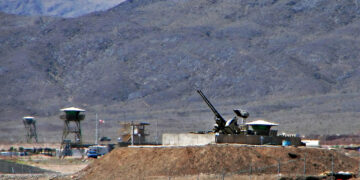
Featuring Rosemary Kelanic
October 16, 2025
Featuring Daniel Davis
October 15, 2025
Events on Houthis


